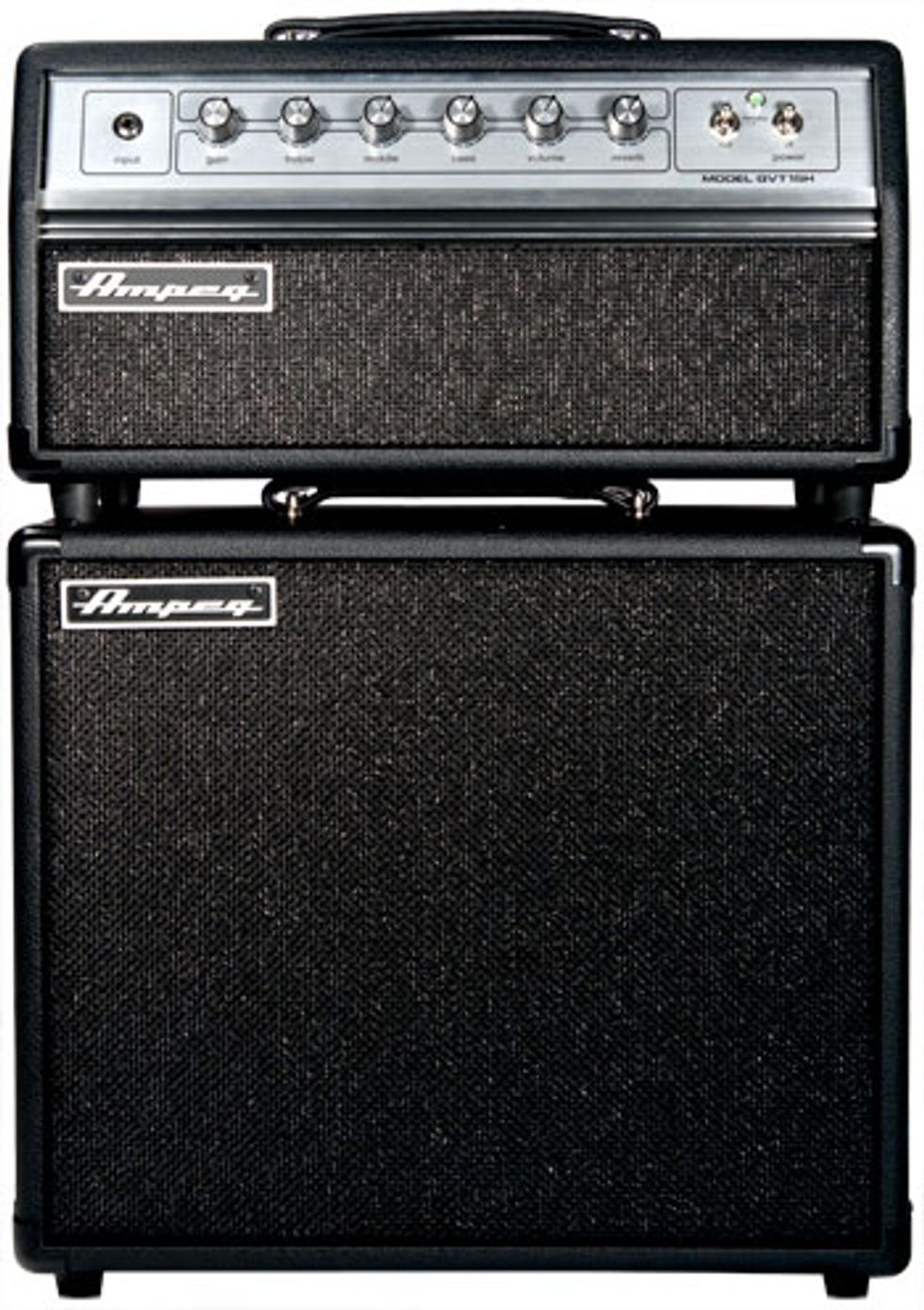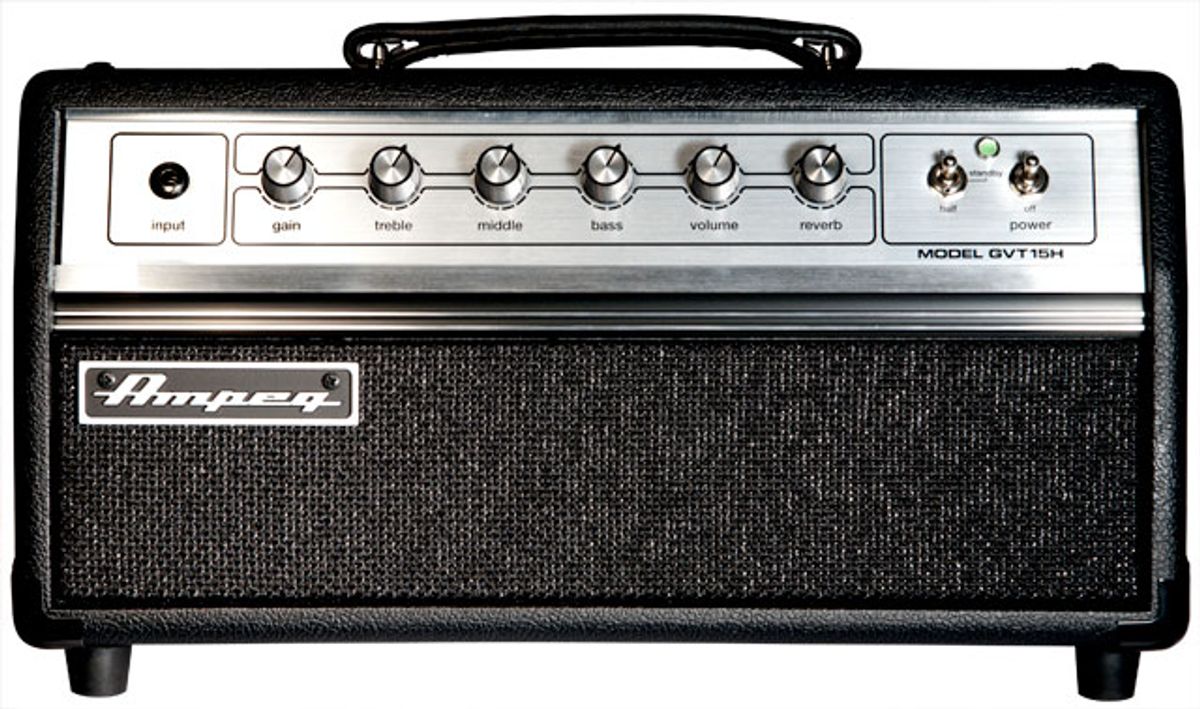Capable of the characteristic cleans and light overdrive that made its predecessors famous, the amp is also able to achieve high gain at less-than-ear-splitting volumes.
Ampeg Amplification’s guitar amplifiers of the ’70s were designed to stay clean at high volumes—a notion that set them apart in an era when it seemed everyone was trying to get overdriven tones at lower volumes. Despite Ampeg’s efforts, players quickly realized that pushing those clean Ampegs into overdriven territory yielded some very unique tones, and their sound quickly became a mainstay in the rock and pop music of that decade.
Fast-forward a few decades later, Ampeg has introduced the new GVT series a range of amps including the GVT15H reviewed here. It’s designed with a slightly different mindset than its ancestors—so while it’s capable of the characteristic cleans and light overdrive that made its predecessors famous, it’s also able to achieve high gain at less-than-ear-splitting volumes.
Honey, I Shrunk the V4
The GVT15H is a clear nod to Ampeg’s second golden age, even if it isn’t based on any specific model from the late ’60s or ’70s. Still, the tiny, 12 lb head looks like a shrunken V4 model with a similar control layout to match.
The amp’s all-tube circuit is driven with the help of a pair of 6V6 power tubes and a pair of 12AX7s in the preamp. There’s only one channel in the GVT15H, and simplicity and straight-forward tone is clearly the aim here. But there’s still a lot of tone-shaping potential, starting with controls for Gain, Treble, Midrange and Bass. Output is controlled by a simple master volume control and options for 15 watt or 7.5 watt output, which you can select with the standby switch.
Interestingly—and this is a high point if you’re a fan of vintage Ampeg amps—the three-band EQ section utilizes a Baxandall EQ configuration. If you’re like most players, you’ve probably rarely heard of this type of EQ, but when well executed the type is typically much more interactive than more common multi-band stack. Dropping the highs and lows can actually boost the midrange in a Baxandall EQ, and while it can take some getting used to, when used properly it makes the amp sound much more distinct. It was a hallmark in old Ampeg amp designs, and a big reason why so many players gravitate toward those classic pieces of gear.
Ampeg also managed to cram a small spring reverb tank into the chassis, along with a series effects loop. Both can be switched in and out (hard bypass) of the circuit via an optional two-button footswitch that can be ordered from Ampeg.
Blast from the Past

The head was tested through the amp’s matching closed-back cabinet—a GVT112E—which was loaded with a 12” Celestion Vintage 30 speaker. The combination of Celestion’s tried-and-true Vintage 30 with the Ampeg’s luscious voice was a great match—full of detail in the highs and lower midrange and infused with that classic vintage Ampeg clean tone that’s moderately bright with a trace of darkness that tames the high end.
With a 2011 Fender American Stratocaster out in front of the GVT15H, gingerly picked, arpeggiated chord progressions were warm and enveloping. As I delved into more country and rock oriented fills and progressions, the snappy, staccato picking style coaxed juicy grit in the mids while the amp displayed remarkable touch sensitivity.
A Gibson Les Paul Traditional coaxed both fluid gain and brawny midrange from the little Ampeg. Nudging the gain control makes the tone beefier and adds sting in the high end that becomes more vicious the higher I went. The added low end can make things surprisingly bottom heavy too, and I had to be careful to keep the Bass control around noon at higher volumes and gain settings to keep from washing out the rest of the tone spectrum.
The amp really kicks into high gear when you crank the master volume above two o’clock, pushing the power section into beautiful, velvety overdrive that works in tandem with the amp’s preamp gain. Thrash metal guitarists need not apply, but heavy rockers who appreciate high gain rhythm tones, ranging from classic ’70s raunch to early ’90s grunge, will be psyched. The only problem with achieving higher gain tones at maximum wattage is that the GVT15H can be surprisingly loud. The option to bump volume down to 7.5 watts is invaluable.
The Verdict
In terms of packing the classic, bright-with-trace-of-darkness Ampeg tones of yesteryear into a compact package, Ampeg did a great job. The cleans have a stark, but full-bodied nature to them, and the overdrive tones can be quite stunning—provided that the bass is adequately dialed back to let the rest of the frequencies shine through. If you’re a fan of the throwback ’70s tones that Ampeg helped define decades ago—but need to keep the volume level in check—it’s a pretty sweet deal.
Watch the video review:
Buy if...
your tone jones is about dark-voiced, brawny tones of ’70s classic rock at manageable volumes.Skip if...
you need more power or a gain channel designed for very aggressive metal work.Rating...


